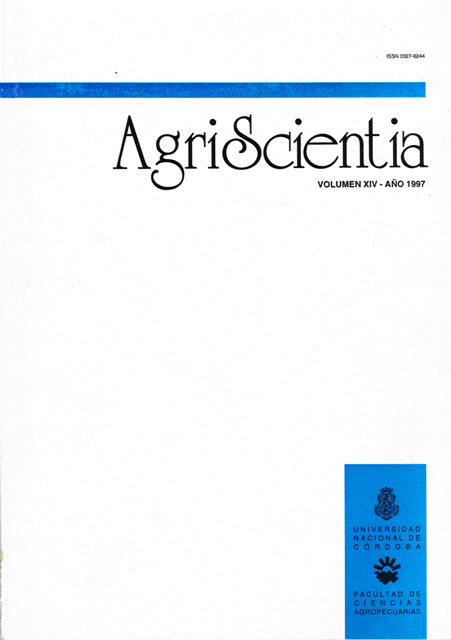Efectos del genotipo, el medio ambiente y las interacciones GxE sobre el índice meiótico en triticale hexaploide (Triticosecale Wittmack)
Contenido principal del artículo
Resumen
El triticale (Triticosecale Wittmack) es una especie aloploide artificial adaptada a zonas de cultivo marginales, incluyendo condiciones de semiaridez. Diversos estudios han analizado el efecto del genotipo y del ambiente sobre las irregularidades meióticas. Los objetivos de este estudio fueron determinar: 1) la existencia de variabilidad genética para el índice meiótico; 2) el efecto de dos regímenes hídricos sobre este carácter; 3) la presencia de interacción entre ambos factores. Seis variedades comerciales de triticale hexaploide fueron sometidas a dos regímenes de humedad: con y sin riego. Se observaron diferencias significativas entre los seis genotipos estudiados, no así entre los regímenes hídricos. Sin embargo, se constataron interacciones genotipo-ambiente significativas, lo que indica un comportamiento diferencial de algunos genotipos según el régimen hídrica un comportamiento diferencial de algunos genotipos según el régimen hídrico de cultivo. Estos resultados sugieren una relación entre índice meiótico y origen del germoplasma.
Detalles del artículo

Esta obra está bajo una licencia internacional Creative Commons Atribución-CompartirIgual 4.0.
Cómo citar
Referencias
Abdalla 0. and R.M. Trethowan. 1990. Expression of agronomic traits in triticale and other small grains under different moisture regimes. In: Proc. 2nd. Int. Triticale Symp. Passo Fundo. Brazil. 246-248.
Boyd, W.J.R., N.S. Sisodia and E.N. Larter, 1970. A comparative study of the cytological and reproductive behaviour of wheat and triticale subjected to two temperature regimes. Euphytica 19: 490-497.
Falgao, T.M.M., M.I.B. Moraes-Fernandes and M.H.B. Zanettini, 1990. Genotypic and environmental effects on chromosomal abnormalities in hexaploid triticale grown in southern Brazil and correlation between meiotic behaviour and fertility of progenies. In: Proc. 2nd. Int. Triticale Symp. Passo Fundo. Brazil. 320-328.
Gustafson, J.P. and C.D. Qualset, 1975. Genetics and breeding of 42-chromosome triticale. II Relations between chromosomal variability and reproductive characters. Crop Sci. 15: 810-813.
Jessop, R.S., 1996. Stress tolerance in newer triticales compared to other cereals. In: Guedes-Pinto H, Darvey N and Carnide V.P. editors. Triticale: Today and Tomorrow. Kluwer Academic Publishers. 419-427.
Manero de Zumelzú, D., A. Ord6nez, R. Maich and L. Torres, 1992. Meiotic irregularities in hexaploid triticale (Triticosecale Wittmack). Variability analysis. Cereal Res. Comm 20 (1-2):125-130.
Namuco, O.S. and J.C. O'Toole, 1986. Reproductive stage water stress and sterility. Effect of stress during meiosis, Crop Sci. 26: 317-321.
Ochoa de Suarez, B., D. Manero de Zumelzú and R. Macchiavelli, 1987. Citogenética de triticales. Aberraciones mei6ticas en triticales hexaploides. Rev. Cs. Agrop. V: 135-144.
Pfeiffer, W.H., K.D. Saire and R.M. Trethowan, 1990. An integrated strategy utilizing line source gradients to develop input responsive triticales adapted to moisture stress. In: Proc. 2nd. Int. Triticale Symp. Passo Fundo. Brazil. 116-120.
Reddy, V.R.K., 1992. Role of temperature on meiotic stability in barley, triticale and wheat. Crop Res. 5 (3): 471-477.
Sayed, I.H., 1982. Response of wheat and triticale cultivars grown under field conditions to drought stress, Wheat Inf. Service. 55: 42-47.
Scovmand, B., P.N. Fox and R.L. Villareal, 1984. Triticale in commercial agriculture: progress and promise. Adv. Agron. 37:1-45.
Stankova, P. and Matsov B., 1982. Drought resistance of some local and introduced wheat and triticale varieties. Fiziologiya na Rasteniyata. 8 (2): 84-92.
Szpiniak de Ferreira, B., 1983. Relac16n entre fertilidad e índice meiótico en 8 cultivares de triticale (Triticosecale Wittmack). Mendeliana. VI (1): 43-54.
Thomas, J.B., P.J. Kaltsikes and S. Shigenaga, 1983 Effect of chromosome 1 B, chromosome 66 and low temperature on the frequency of chromosome pairing at first meiotic metaphase in hexaploid triticale. Can. J. Genet. Cytol. 25 (3): 278-282.
Trethowan, R.M., O. Abdalla and W.H. Pfeiffer, 1990. Evaluation of the rate and duration of the grain filling in triticale and its association with agronomic traits. In: Proceedings. 2nd. Int. Triticale Symp. Passo Fundo. Brazil. 128-130.





